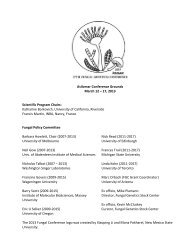Asperfest 4 Program - Fungal Genetics Stock Center
Asperfest 4 Program - Fungal Genetics Stock Center
Asperfest 4 Program - Fungal Genetics Stock Center
You also want an ePaper? Increase the reach of your titles
YUMPU automatically turns print PDFs into web optimized ePapers that Google loves.
40. Dual genome microarray: Fusarium verticillioides and Aspergillus flavus gene expression in co-culture. Daren W. Brown<br />
Mycotoxin Research Unit, U.S. Department of Agriculture-ARS, Peoria, IL 61604<br />
Aflatoxins produced by Aspergillus flavus and fumonisins produced by Fusarium verticillioides are prominent among the mycotoxins<br />
associated with economic losses to the maize grain industry worldwide. F. verticillioides is also recognized as a systemic endophyte<br />
of maize that prevents opportunistic saprotrophs such as A. flavus from spreading within the ear and rotting the seeds. Protective<br />
endophtyes are potential sources of gene products that can suppress fungal growth or silence genes critical to mycotoxin synthesis<br />
that are a priori adapted to function in planta. F. verticillioides genes that serve to augment maize host defenses are likely to exhibit<br />
patterns of expression that are correlated with exposure to fungal competitors. We have designed a NimbleGen Systems microarray<br />
based on over 25,000 A. flavus and F. verticillioides genes derived from genomic and EST data. Each probe set consists of up to<br />
twelve 60-mer oligonucleotides specific to each gene sequence. This report describes gene expression changes in both F.<br />
verticillioides and A. flavus due to co-culture on a maize based medium.<br />
41. Comparative analysis of secondary metabolism gene clusters from two strains of Aspergillus fumigatus and closely related<br />
1 1 1 1<br />
species Neosartorya fischeri and Aspergillus clavatus. Natalie Fedorova , Vinita Joardar , Jonathan Crabtree , Rama Maiti , Paolo<br />
1 2 1 3 1 1<br />
Amedeo , David Denning , Jennifer Wortman , Geoffrey Turner , and William Nierman . The Institute for Genomic Research,<br />
2<br />
Rockville, MD, USA; School of Medicine and Faculty of Life Sciences, The University of Manchester, Manchester, UK;<br />
3<br />
Department of Molecular Biology and Biotechnology, University of Sheffield, Sheffield, UK. Email: natalief@tigr.org<br />
Genes responsible for biosynthesis of secondary metabolites are often referred to as the most variable segment of fungal genomes.<br />
Comparative analysis of secondary metabolism gene clusters from A. fumigatus and the two closely related species confirmed that<br />
these organisms are indeed relentlessly updating their repertoire of mycotoxins. Out of 23 clusters identified in A. fumigatus, only<br />
seven have putative orthologs in the other two aspergilli. Most of these ‘core’ clusters are highly conserved and appear to be under<br />
strong negative selection. The rest of the clusters, however, are species- or even strain-specific, implying that the aspergilli must<br />
utilize specific mechanisms to ensure a quick divergence and turnover of clusters in the course of evolution. These mechanisms may<br />
involve de-novo assembly, segmental duplication, translocation, accelerated differentiation, and differential loss of clusters in various<br />
lineages.<br />
42. Improvements in Aspergillus fumigatus annotation. Paolo Amedeo, Natalie Fedorova, Rama Maiti, Vinita Joardar, Crabtree<br />
Jonathan, Samuel Angiuoli, William Nierman, Owen White, Jennifer Russo Wortman The Institute for Genomic Research, 9712<br />
Medical <strong>Center</strong> Dr., Rockville, MD 20850<br />
Aspergillus fumigatus has been one among the first fungal genomes to be fully sequenced and annotated. The almost complete absence<br />
of genes belonging to closely-related organisms, in public databases, had influenced negatively the quality of annotation. Recently,<br />
several other Aspergillus species have been fully sequenced and annotated. Moreover, during these past years, annotation tools have<br />
been considerably improved. Leveraging on comparative genomic analysis we have revised the annotation of this genome. Here we<br />
describe the process taken and demonstrate the improvements.<br />
1<br />
43. Metabolic network-driven analysis of genome-wide transcription data from Aspergillus nidulans. Helga Moreira David ,<br />
2 2 3 2 1<br />
Gerald Hofmann , Ana Paula Oliveira , Hanne Jarmer , and Jens Nielsen . Fluxome Sciences A/S, Diplomvej 378, 2800 Lyngby,<br />
2 3<br />
Denmark <strong>Center</strong> for Microbial Biotechnology, Technical University of Denmark, 2800 Lyngby, Denmark <strong>Center</strong> for Biological<br />
Sequence Analysis, Technical University of Denmark, 2800 Lyngby, Denmark<br />
Aspergillus nidulans is a model organism for aspergilli, an important group of filamentous fungi that encompasses human and plant<br />
pathogens, as well as industrial cell factories. Aspergilli have a highly diversified metabolism and, because of their medical,<br />
agricultural and biotechnological importance, it is valuable to understand how their metabolism is regulated. We therefore performed<br />
genome-wide transcription analysis of A. nidulans grown on glucose, glycerol, and ethanol with the objective of identifying global<br />
regulatory structures. We furthermore reconstructed the complete metabolic network of this organism, which resulted in linking 666<br />
genes to metabolic functions, as well as assigning metabolic roles to 472 genes that were previously uncharacterized. Through<br />
combination of the reconstructed metabolic network and the transcription data, we identified subnetwork structures that pointed to<br />
coordinated regulation of genes involved in many different parts of the metabolism. Thus, for a shift from glucose to ethanol, we<br />
identified a coordinated regulation of the complete pathway for oxidation of ethanol, as well as up-regulation of gluconeogenesis and<br />
down-regulation of glycolysis and the Pentose Phosphate (PP) pathway. Furthermore, upon a change in the carbon source from<br />
glucose to ethanol, the cells shift from using the PP pathway as the major source of NADPH for biosynthesis to use of the malic<br />
enzyme. Our analysis indicated that some of the genes are regulated by common transcription factors, making it possible to establish<br />
new putative links between known transcription factors and genes, through clustering.<br />
4th International Aspergillus Meeting 18 Poster Abstracts











